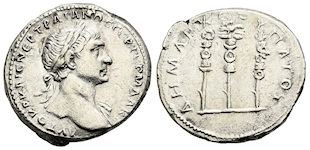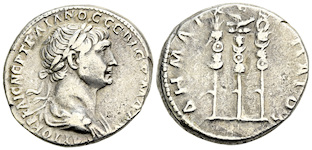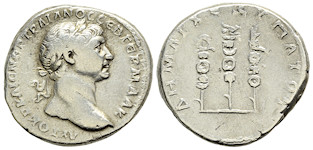Fine Coins Showcase
Antiquities Showcase
Show Empty Categories
Shop Search
Shopping Cart
My FORVM
Contact Us
About Forum
Shopping at Forum
Our Guarantee
Payment Options
Shipping Options & Fees
Privacy & Security
Forum Staff
Selling Your Coins
Identifying Your Coin
FAQs
zoom.asp
Home ▸ Catalog ▸ |Roman Coins| ▸ |Roman Mints| ▸ |Rome||View Options:   | | | | | | Dates of operation: c. 289 - 40 B.C. and 20 B.C. - 476 A.D. Mintmarks: R, RM, ROM, ROMA, ROMOB, VRB ROM, SMR. |


In Roman mythology, Aequitas was the minor goddess of fair trade and honest merchants. Aequitas was also the personification of the virtues equity and fairness of the emperor (Aequitas Augusti). The scales, a natural emblem of equity, express righteousness. The cornucopia signifies the prosperity which results from Aequitas and Aequitas Augusti.SL113464. Silver denarius, RIC II 13, RSC II 6, BnF III 13, BMCRE III 24, Hunter I 9, SRCV II -, NGC Ch AU, strike 4/5, surface 5/5 (2400906-010), weight 3.32 g, maximum diameter 18.5 mm, die axis 180o, Rome mint, 97 A.D.; obverse IMP NERVA CAES AVG P M TR P COS III P P, laureate head right; reverse AEQVITAS AVGVST (fairness of the emperor), Aequitas standing half left, head left, wearing stephane, scales in right hand, cornucopia in left hand; from a Virginia Collector, ex Eastern Numismatics Inc. (Garden City, NY, 20 Dec 2010, $2140); NGC| Lookup;
Lucius Verus, 7 March 161 - February 169 A.D.


In 162, Lucius Verus began war with the Parthians after Vologases IV invaded Syria and Armenia. The Romans would be victorious but the returning army would bring back a pandemic known as the Antonine Plague. The plague would significantly depopulate the entire Roman Empire.SL113468. Silver denarius, RIC III p. 253, 482; RSC II 155; BMCRE IV p. 412, 202; Hunter II p. 368, 7; cf. SRCV II 5354 (TR P III), NGC Ch AU, strike 5/5, surface 4/5 (3989805-005), weight 2.88 g, maximum diameter 17 mm, die axis 180o, Rome mint, Dec 161 - Dec 162 A.D.; obverse IMP L AVREL VERVS AVG, bare head right; reverse PROV DEOR TR P II COS II, Providentia standing facing, head left, globe in right hand, cornucopia in left hand; from a Virginia Collector, ex Eastern Numismatics Inc. (Garden City, NY, 21 Mar 2016, $995); NGC| Lookup;
Severus Alexander, 13 March 222 - March 235 A.D.


This coin was dedicated to Jupiter, the defender, probably to ask for protection the emperor in his war against the Persians. As Jupiter was the king of the gods, he took more interest in kings and emperors than the common man.SL114187. Silver denarius, RIC IV 238, RSC III 83, BMCRE VI 824, Hunter III 71, SRCV II 7871, NGC CH MS*, strike 5/5, surface 5/5 (2406773-001), weight 2.74 g, maximum diameter 21 mm, die axis 0o, Rome mint, 231 - 235 A.D.; obverse IMP ALEXANDER PIVS AVG, laureate, draped, and cuirassed bust right, with a short neatly trimmed beard, seen from the front; reverse IOVI PROPVGNATORI (Jupiter the Defender), Jupiter standing slightly left in fighting attitude, head right, nude but for cloak flying behind, hurling thunderbolt with right, eagle in extended left hand; from the Craig Chambers Collection, NGC| Lookup;
Vitellius, 2 January - 20 December 69 A.D.


This variant with a bare-headed portrait and GERMANICVS shortened to GERMAN is unpublished in the references and missing from the collections examined by FORVM. It is missing from the ANS collection. We know of two other specimens from auction records on Coin Archives.SL115013. Silver denarius, RIC I 73 var.; RSC II 20 var.; Hunter I 3 var. ; BMCRE I 7 var., BnF III 38 var. (all with laureate head right), NGC F (6710501-002), weight c. 3.2 g, maximum diameter 17.0 mm, die axis 180o, Rome mint, c. late Apr - Jul 69 A.D.; obverse A VITELLIVS GERMAN IMP TR P, bare head right; reverse CONCORDIA P R (harmony with the people of Rome), Concordia seated left, patera in right hand, cornucopia in left hand; ex Stack's Bowers World CCO Auction (26 Feb 2024), lot 74103; NGC| Lookup; extremely rare;
Trajan, 25 January 98 - 8 or 9 August 117 A.D., Arabian Tridrachm Series, "Rome" Style


In a 1997 book review in the Schweizerische Numismatische Rundschau (SNR), Kevin Butcher agreed with William Metcalf that the Greek inscribed silver "coinage of Trajan dated to his sixth consulship" is part of the "Rome style" club. He goes on to write, "The existence of this Rome style coinage in the eastern provinces caused great confusion in the past, with a whole series of coins which we now know belong to Syria, Arabia and Cyrenaica being given to Caesarea by Sydenham. It is largely thanks to M.'s [Metcalf's] work on Caesarea and the Arabian coinage that most of the issues have been reattributed away from Caesarea. The source of confusion was the stylistic similarity of all of these groups, because they are all in the style of the Rome mint." Just how involved Rome was in the minting of these coin groups is still a mystery. Its complexity is suggested by a probable Rome style Arabian drachm of Trajan (RPC III 4075) overstruck on a Nabatean drachm. See FORVM RS113121 for this example!
The obverse legend sports what appears on first glance to be a glaring error: CEP in place of CEB, but the comparison of another coin from the same die pair assures us that the die cutter did not allow such a blunder to mar his masterful work. This includes rejecting the scenario where the die cutter simply modified the letter at some point afterwards, since our coin is in a later die state than the other.RY114284. Silver tridrachm, RPC Online III 4055 (15 spec.); Woytek Cistophore A1b.1; Ganschow X14b; SNG Fitz 5436; SNG ANS 1163; Tell Kalak pl. XIII, 9; Sydenham Caesarea 225, gVF, light toning, bold strike with traces of die wear, very fine style, befitting the mint of Rome, weight 10.156 g, maximum diameter 24.5 mm, die axis 180o, struck for use in Arabia by Rome or Arabian mint, "Tr Pot Cos VI" issue, 112 - 114 A.D.; obverse AYTOKP KAIC NEP TPAIANOC CEB ΓEPM ΔAK (Imperator Caesar Nerva Traianus Augustus Germanicus Dacicus), laureate bust right, slight drapery on far (left) shoulder; reverse ΔHMAPX EΞ YΠATO ϛ (tribunicia potestate, consul VI - holder of Tribunician power, consul six times), aquila between two signa (standards), wreath on top of left signum, hand on top of right signum;
Trajan, 25 January 98 - 8 or 9 August 117 A.D., Arabian Tridrachm Series, "Rome" Style


In a 1997 book review in the Schweizerische Numismatische Rundschau (SNR), Kevin Butcher agreed with William Metcalf that the Greek inscribed silver "coinage of Trajan dated to his sixth consulship" is part of the "Rome style" club. He goes on to write, "The existence of this Rome style coinage in the eastern provinces caused great confusion in the past, with a whole series of coins which we now know belong to Syria, Arabia and Cyrenaica being given to Caesarea by Sydenham. It is largely thanks to M.'s [Metcalf's] work on Caesarea and the Arabian coinage that most of the issues have been reattributed away from Caesarea. The source of confusion was the stylistic similarity of all of these groups, because they are all in the style of the Rome mint." Just how involved Rome was in the minting of these coin groups is still a mystery. Its complexity is suggested by a probable Rome style Arabian drachm of Trajan (RPC III 4075) overstruck on a Nabatean drachm. See FORVM RS113121 for this example!
RY114285. Silver tridrachm, RPC Online III 4060, Metcalf Tell Kalak 13, SNGvA 6399, Woytek Cistophore A1v.2, Ganschow X14e, Sydenham Caesarea -, VF, toned surfaces, worn rev. die, obv. of fine style, superb portrait, weight 9.842 g, maximum diameter 23.2 mm, die axis 225o, struck for use in Arabia by Rome or Arabian mint, "Tr Pot Cos VI" issue, 112 - 114 A.D.; obverse AYTOKP KAIC NEP TPAIANOC CEB ΓEPM ΔAK, laureate and draped bust right, seen from front; reverse ΔHMAPX EΞ YΠATO ϛ (holder of Tribunician power, consul six times), two standards (signa) flanking an aquila with hand atop left standard and wreath atop right standard; very rare;
Trajan, 25 January 98 - 8 or 9 August 117 A.D., Arabian Tridrachm Series, "Rome" Style


In a 1997 book review in the Schweizerische Numismatische Rundschau (SNR), Kevin Butcher agreed with William Metcalf that the Greek inscribed silver "coinage of Trajan dated to his sixth consulship" is part of the "Rome style" club. He goes on to write, "The existence of this Rome style coinage in the eastern provinces caused great confusion in the past, with a whole series of coins which we now know belong to Syria, Arabia and Cyrenaica being given to Caesarea by Sydenham. It is largely thanks to M.'s [Metcalf's] work on Caesarea and the Arabian coinage that most of the issues have been reattributed away from Caesarea. The source of confusion was the stylistic similarity of all of these groups, because they are all in the style of the Rome mint." Just how involved Rome was in the minting of these coin groups is still a mystery. Its complexity is suggested by a probable Rome style Arabian drachm of Trajan (RPC III 4075) overstruck on a Nabatean drachm. See FORVM RS113121 for an example!RY114286. Silver tridrachm, RPC Online III 4062A (5 spec.), Woytek Cistophore A1h.1, Ganschow X14d, cf. Metcalf Tell Kalak 8-10 (diff. busts), Sydenham Caesarea 224-226 (same), gVF, great centering, fine style obv. showcasing a high point in Roman imperial portraiture, patch of roughness on neck, otherwise smooth surfaces, mild die wear, weight 10.575 g, maximum diameter 25.1 mm, die axis 180o, struck for use in Arabia by Rome or Arabian mint, "Tr Pot Cos VI" issue, 112 - 114 A.D.; obverse AYTOKP KAIC NEP TPAIANOC CEB ΓEPM ΔAK, laureate, draped, and cuirassed bust right, seen from front; reverse ΔHMAPX EΞ YΠATO ϛ (holder of Tribunician power, consul six times), two standards (signa) flanking an aquila with wreath atop left standard and hand atop right standard; Published in RPC Online III (#4 = this coin!); very rare;
Trajan, 25 January 98 - 8 or 9 August 117 A.D., Arabian Tridrachm Series, "Rome" Style


In a 1997 book review in the Schweizerische Numismatische Rundschau (SNR), Kevin Butcher agreed with William Metcalf that the Greek inscribed silver "coinage of Trajan dated to his sixth consulship" is part of the "Rome style" club. He goes on to write, "The existence of this Rome style coinage in the eastern provinces caused great confusion in the past, with a whole series of coins which we now know belong to Syria, Arabia and Cyrenaica being given to Caesarea by Sydenham. It is largely thanks to M.'s [Metcalf's] work on Caesarea and the Arabian coinage that most of the issues have been reattributed away from Caesarea. The source of confusion was the stylistic similarity of all of these groups, because they are all in the style of the Rome mint." Just how involved Rome was in the minting of these coin groups is still a mystery. Its complexity is suggested by a probable Rome style Arabian drachm of Trajan (RPC III 4075) overstruck on a Nabatean drachm. See FORVM RS113121 for this example!RY114288. Silver tridrachm, RPC Online III 4053 (25 spec.); Woytek Cistophore A1a.1; Tell Kalak pl. XIII, 8; SNG ANS 1162; BMC Galatia p. 57, 88; Ganschow X14a, aVF, fine style portrait, very lightly toned minor hairline scratches, traces of die wear, weight 10.166 g, maximum diameter 23.8 mm, die axis 210o, struck for use in Arabia by Rome or Arabian mint, "Tr Pot Cos VI" issue, 112 - 114 A.D.; obverse AYTOKP KAIC NEP TPAIANOC CEB ΓEPM ΔAK (Imperator Caesar Nerva Traianus Augustus Germanicus Dacicus), laureate head (or bust) right; reverse ΔHMAPX EΞ YΠATO ϛ (tribunicia potestate, consul VI - holder of Tribunician power, consul six times), aquila between two signa (standards), wreath on top of left signum, hand on top of right signum;
Trajan, 25 January 98 - 8 or 9 August 117 A.D.


In 107 A.D., Trajan received an ambassador from India. In 108 A.D., "doctor's offices" opened in Rome replacing "house calls.RS113935. Silver denarius, Woytek 270b, BnF IV 276, RIC II 128, RSC II 74, BMCRE III 328, Hunter II 104, Strack I 128, SRCV II 3129, EF, centered on a tight flan, attractive portrait, attractive toning, weight 3.505 g, maximum diameter 17.4 mm, die axis 180o, Rome mint, 107 - 108 A.D.; obverse IMP TRAIANO AVG GER DAC P M TR P, laureate bust right, slight drapery on far shoulder; reverse COS V P P S P Q R OPTIMO PRINC, Victory standing slightly left, naked to hips, raising wreath in right hand, palm frond in left hand; from the Chris Noah Collection (purchased spring 2006);
Philip II, July or August 247 - Late 249 A.D.


When Augustus ruled Rome, he was not called emperor or king, he was the Princeps, the "first of men." In the empire, the designated successors to the emperor were named caesar and also given the title Princeps Juventutis, the "first of youths." This is the origin of the English word prince, meaning the son of a monarch.SL114189. Silver antoninianus, RIC IV 218d, RSC IV 48, Hunter V 8, SRCV III 9240, NGC MS, strike 5/5, surface 3/5, grainy (2406772-001), weight 4.02 g, maximum diameter 21 mm, die axis 0o, Rome mint, as caesar, 244 - 246 A.D.; obverse M IVL PHILIPPVS CAES, radiate and draped bust right, seen from behind; reverse PRINCIPI IVVENT (to the Prince of Youth), Philip II standing slightly left, head left, wearing military dress, globe in extended right hand, inverted spear in left hand; from the Craig Chambers Collection, NGC| Lookup;
CLICK HERE TO SEE MORE FROM THIS CATEGORY - FORVM's PRIOR SALES



REFERENCES|
Page created in 1.39 seconds.








